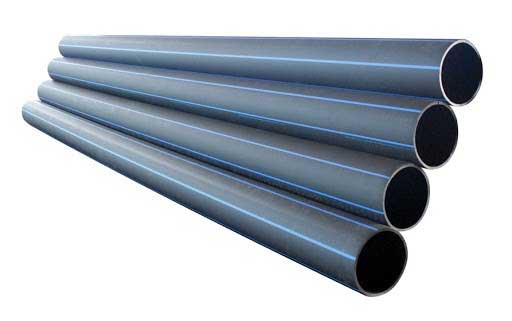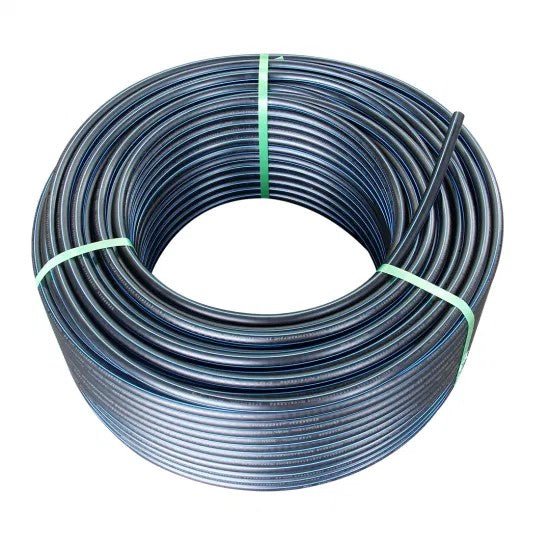Practical Overview to hdpe pipe fittings Midland TX and Their Applications
Explore the Manufacturing Process Behind High-Quality HDPE Pipeline and Its Applications
The manufacturing process of top quality HDPE pipelines is elaborate and methodical. It begins with the option of basic materials that enhance performance. Following this, ethylene undergoes polymerization to develop resin, which is after that shaped via extrusion. Quality control is vital, ensuring that the last product meets rigid standards. Nonetheless, the trip of HDPE pipes doesn't end with production. Their applications across various industries reveal a more comprehensive importance worth taking a look at.
Recognizing HDPE: Characteristics and Advantages

High-density polyethylene (HDPE) is a versatile thermoplastic known for its sturdiness and resistance to various environmental aspects. This product displays outstanding tensile strength, making it ideal for requiring applications. Its low-density framework contributes to a light-weight item, facilitating convenience of dealing with and installment. HDPE also showcases exceptional resistance to chemicals, which reduces degradation when exposed to rough materials.
The material's reduced wetness absorption additionally enhances its long life, making it ideal for use in pipes and storage space containers. Furthermore, HDPE is immune to ultraviolet (UV) radiation, making certain that items keep their honesty also when subjected to sunlight. Its versatility permits for the development of intricate forms without endangering toughness. The environmentally friendly nature of HDPE, typically stemmed from recycled products, adds to its charm, promoting lasting techniques in production. On the whole, these properties and benefits make HDPE a favored selection for different industrial and consumer applications.
Basic Material Option for HDPE Manufacturing
The choice of basic materials for HDPE production is vital to validate the end product fulfills the wanted requirements and high quality criteria. High-density polyethylene (HDPE) is mostly produced from polymerized ethylene, stemmed from fossil fuels such as gas or unrefined oil. The quality of these feedstocks greatly affects the mechanical and thermal residential or commercial properties of the final HDPE.
Ingredients additionally play a significant role in enhancing HDPE's efficiency, including antioxidants, UV stabilizers, and colorants, which improve longevity and resistance to environmental elements. The selection procedure need to consider not only the chemical structure of the raw materials yet likewise their processing features to ensure reliable manufacturing.
The sourcing of raw materials ought to focus on sustainability and compliance with environmental regulations, as accountable techniques are vital in today's market. Inevitably, mindful resources selection lays the foundation for creating top quality HDPE pipelines ideal for diverse applications.
The Extrusion Refine: Forming HDPE Pipe
The extrusion process plays an important duty fit HDPE pipelines, starting with thorough product prep work strategies that guarantee excellent circulation and consistency. Just as crucial is the design of the die, which straight affects the last measurements and surface area quality of the pipeline. Together, these variables add substantially to the effectiveness and quality of HDPE pipe manufacturing.
Product Prep Work Methods
Reliable production of HDPE pipes begins with precise material prep work methods, especially the extrusion process. Throughout this phase, high-density polyethylene material is very first dried out to get rid of moisture, making certain ideal circulation attributes. The material is after that fed into the extruder, where it undergoes heating and melting, transforming right into a thick state. This heating process is very carefully controlled to preserve the material's stability and efficiency. The molten HDPE is compelled with a die, shaping it right into a constant pipeline type. Appropriate temperature level monitoring throughout extrusion is necessary, as it directly influences the product's buildings and the end product high quality. As soon as shaped, the HDPE pipeline is cooled and cut to specified sizes, ready for succeeding handling and applications.
Die Style Importance
Accuracy in die layout plays a company website necessary function in the extrusion procedure of HDPE pipelines. The die functions as the last shaping tool, straight affecting the pipeline's dimensions, wall density, and surface finish. A properly designed die warranties consistent material flow, reducing defects such as abnormalities and weak points. The geometry of the die should be enhanced to fit the details homes of HDPE, including its viscosity and thermal behavior throughout extrusion. In addition, the cooling price of the product as it goes through the die can substantially affect the pipeline's structural integrity. Subsequently, buying advanced die innovation is vital for suppliers intending to produce premium HDPE pipes that satisfy industry criteria and customer expectations.
Quality Control Actions in HDPE Manufacturing
Various variables influence the quality of HDPE pipeline manufacturing, reliable quality control procedures are critical to guarantee uniformity and integrity in the final item (hdpe pipe in stock Midland TX). Key high quality control practices consist of strenuous material examination, verifying that the raw polyethylene satisfies well established criteria for purity and thickness. During the extrusion process, criteria such as temperature, pressure, and cooling time are click now closely kept track of to maintain dimensional precision and structural stability
In enhancement, post-production screening is essential; suppliers usually perform hydrostatic tests to assess the pipe's stamina and resistance to stress. Visual evaluations for surface flaws better boost quality control. Certification from pertinent requirements organizations, like ASTM or ISO, gives an extra layer of reliability. By implementing these comprehensive top quality control steps, manufacturers can minimize problems, enhance efficiency, and make sure that the HDPE pipes meet the certain requirements of numerous applications, inevitably leading to client satisfaction and rely on the product.
Applications of HDPE Pipeline Throughout Industries
HDPE pipelines are made use of across different industries because of their durability and versatility. In water circulation systems, they ensure effective distribution, while in wastewater administration, they give dependable options for waste transportation. In addition, agricultural irrigation networks profit from HDPE's resistance to corrosion and flexibility, making it an excellent option for contemporary farming techniques.

Water Circulation Equipments
A substantial number of sectors count on high-density polyethylene (HDPE) pipes for efficient water circulation systems. Understood for their durability and resistance to rust, HDPE pipes are extensively used in community supply of water networks, agricultural watering, and commercial applications. Their lightweight nature promotes very easy handling and installation, reducing labor costs and time. Additionally, HDPE pipes can fit numerous pressure degrees, making them ideal for both low and high-pressure systems. American Plastics HDPE Pipe for Oilfield. The flexibility of the product enables for smooth integration into existing infrastructure, decreasing the demand for substantial excavation. HDPE's resistance to chemical leaching assurances that the water supplied stays safe and tidy, making it an ideal option for maintaining the top quality of drinkable water throughout different industries.
Wastewater Management Solutions
Effective water circulation systems likewise pave the method for innovative wastewater monitoring remedies, where high-density polyethylene (HDPE) pipes play a significant function. Prominent for their longevity and resistance to deterioration, HDPE pipes are perfect for transporting wastewater in numerous settings. Their versatility enables simple installment in complex environments, lessening the requirement for extensive excavation. Furthermore, HDPE's smooth indoor surface area decreases rubbing, enhancing flow rates and effectiveness. These pipes are also immune to chemical leaching, ensuring that pollutants do not endanger the surrounding environment. Industries, municipalities, and therapy centers significantly depend on HDPE pipelines for their dependability and longevity, making them a preferred option for modern-day wastewater management systems. This versatility underscores the essential importance of HDPE pipelines across many applications.
Agricultural Watering Networks
Agricultural watering networks profit significantly from using high-density polyethylene (HDPE) pipelines, which supply effective and dependable water shipment to plants. HDPE pipes are lightweight, making them simple to transfer and install, while their versatility permits different setups in diverse surfaces. These pipes show exceptional resistance to rust, chemicals, and UV radiation, guaranteeing durability in severe agricultural settings. Furthermore, their smooth indoor surface minimizes friction loss, optimizing water flow and lowering power prices connected with pumping. The durability of HDPE pipelines, typically going beyond half a century, adds to decrease maintenance and replacement costs. Consequently, farmers significantly count on HDPE pipes to enhance watering efficiency and promote lasting farming techniques, inevitably leading to improved crop yields and resource conservation.
Future Fads in HDPE Pipeline Technology
As the demand for lasting and effective infrastructure expands, improvements in HDPE pipeline technology are positioned to transform numerous industries. Arising patterns consist of the integration of wise modern technologies, such as sensing units and IoT capabilities, which facilitate real-time monitoring of pipeline problems, reducing upkeep expenses and preventing leaks. Furthermore, the growth of innovative production methods, such as 3D printing, is enabling the manufacturing of facility, customized pipe designs that provide to particular job requirements.
The emphasis on recycling and round economic situation techniques is driving the advancement of HDPE pipes made from recycled materials, enhancing sustainability. Enhanced jointing approaches, such as electro-fusion and mechanical installations, are likewise boosting installation effectiveness and integrity. The expanding focus on environmental guidelines is pressing suppliers to embrace greener production procedures, making sure that HDPE pipelines not just meet sector requirements however likewise promote a more sustainable future for framework advancement.
Often Asked Inquiries
How Does HDPE Compare to Other Plastic Materials?
HDPE exceeds numerous other plastic materials relating to toughness, chemical resistance, and versatility. Its reduced thickness and high tensile toughness make it perfect for numerous applications, frequently going beyond options in both performance and longevity.
What Are the Environmental Impacts of HDPE Manufacturing?
The ecological influences of HDPE production consist of greenhouse gas exhausts, power consumption, and possible pollution from producing procedures. In addition, inappropriate disposal can cause soil and water contamination, increasing issues about lasting environmental impacts.
Can HDPE Piping Be Reused?
Yes, HDPE pipes can be recycled. Several centers approve made use of HDPE for processing, transforming it into brand-new products. This recycling adds to repipe specialists sustainability efforts, minimizing plastic waste while saving resources and energy in the production cycle.
What Is the Life-span of HDPE Water Lines?

Just How Do Temperature Variations Influence HDPE Pipe Performance?
Temperature level variants substantially influence HDPE pipeline efficiency, affecting flexibility and strength. Heats can bring about softening, while low temperatures may cause brittleness, inevitably influencing the pipeline's sturdiness and suitability for various applications in diverse settings.